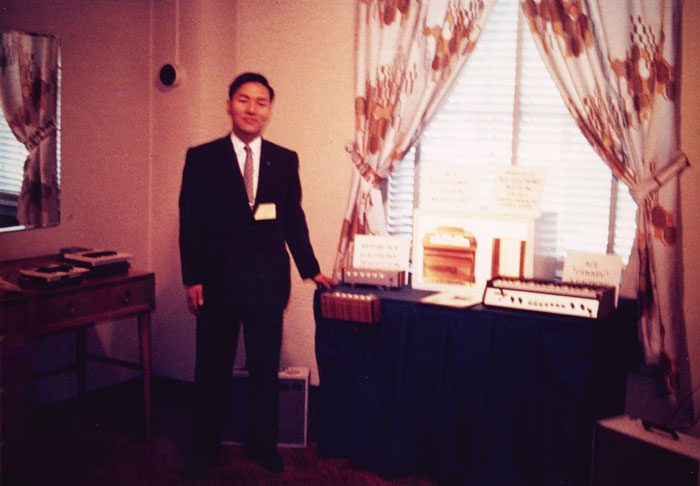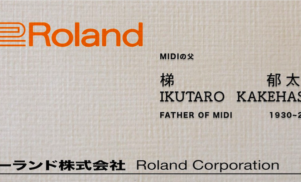It’s almost impossible to imagine what the modern music landscape would sound like had Ikutaro Kakehashi not been born in an Osaka hospital on February 7, 1930. That may sound like hyperbole but simply, the range of now iconic instruments he pioneered as founder of Roland have become mainstays of so many different genres that his stamp genuinely can be felt across almost every inch of what we listen to today. Following his death this weekend aged 87, Ryan Diduck delves into his history.
Ikutaro Kakehashi, founder of Roland Corporation and driving personality behind many of the instruments, technical developments and devices that helped shape the modern electronic music ecosystem, has died aged 87. Tommy Snyder, research and development specialist and Roland V-drum designer, confirmed the death on Saturday via Facebook.
Kakehashi founded his first company, Ace Electronics, in Japan in the early 1960s, manufacturing a small rhythm box called the Ace Tone Rhythm Ace — a device pre-programmed with Waltz, Samba, and Swing settings, intended to fit neatly atop a Hammond organ.
On his first trip to the United States in 1964, Kakehashi demonstrated the Rhythm Ace himself at the North American Music Merchant’s trade show. He converted his room at the Chicago Hilton into a showroom, appropriating a desk for a display table, and curtains as a backdrop. There, Kakehashi sold eight Rhythm Aces—one to each major organ manufacturer—and, by design, struck up a lucrative partnership with Hammond.
As the burgeoning electric organ industry grew, Kakehashi started importing Hammonds from America, becoming the company’s first Asian subsidiary. Laurens Hammond immediately recognized Kakehashi’s potential, enlisting him into a top-secret development program for a new easy-to-play organ. The result of “Project Mustang,” as it was known internally, was the Hammond Piper Autochord, Kakehashi’s first major musical innovation.
Released to success in 1971, the Autochord produced harmonic bass chords from single notes played on the organ keyboard. An advertisement for the instrument was addressed: “To the girl who never finished her music lessons.” Because of its effortlessness, the Autochord was instrumental in the production and domestication of electric organs — a neglected but pivotal chapter in electronic music history.

Kakehashi never received any formal musical training but maintained an immense respect for musicians
Although Kakehashi never received any formal musical training — music education was among many services halted in Japan during World War II — he maintained an immense respect for musicians, developing personal relationships with Duke Ellington, who became a Hammond spokesperson, and Oscar Peterson, who later tested out and made suggestions on early Roland prototypes. Kakehashi understood that for his instruments to be popular in the marketplace, amateurs and professionals alike would have to find them inexpensive, intuitive, small, and most importantly, simple.
In 1971, after Ace Electronics had been sold and resold again to a series of conglomerates, Kakehashi grew dissatisfied, effectively becoming a shareholder in his own company. The following year, he took a courageous turn, leaving behind a profitable business with both Ace and Hammond and founding Roland Corporation. Kakehashi knew that the name of his new company would be almost as important as the products it manufactured: Ace was picked because it started with ‘A’ and signified excellence. He began flipping through an encyclopedia, coming to a halt in the Rs. Chosen after Sir Roland de Velville, the illegitimate son of Henry VII, Roland seemed a bold-sounding name. And the ‘R’ logo, Mr. Kakehashi felt, made a memorable impression.
The TR-77 Rhythm Box was Roland’s first product. And although the company would continue to expand in new directions, notably with its guitar-oriented Boss subdivision, keyboard instruments would remain central to Roland’s business — and Kakehashi’s heart.
Inspired by Bob Moog and Alan R. Pearlman’s initial successes, Roland introduced the SH-1000, a synthesizer programmed with ten preset “patches,” in 1973. Contending in the well-developed American instrument trade meant that Kakehashi’s products would have to be significantly different from those that already existed. While Moog and ARP targeted their instruments at professional musicians and academics, Kakehashi geared his devices for neophytes and amateurs like himself. And so, miniaturization, affordability, and simplicity steered every aspect of Roland’s product development.
Kakehashi made a practice of always looking for partners, in musicians like Ellington and Peterson, but also in his competitors. Witnessing the VHS versus Betamax battle in the Japanese video industry during the late 1970s, Kakehashi keenly identified the benefits of cooperation in the musical instrument business. He began reaching out to American synthesizer manufacturers to produce a universal digital interface that would connect electronic devices regardless of brand name.

Kakehashi’s accomplishments are made even more impressive by the difficult childhood he was forced to overcome
In 1981, Kakehashi initiated negotiations with Tom Oberheim, who had already developed his own machine-control interface called the Oberheim System. But the system was cumbersome and proprietary, and Oberheim seemed set on the idea of a more expensive parallel interface. Kakehashi then turned to Dave Smith, the head of Sequential Circuits, to develop a cheaper and simpler system. Smith would also be charged with rallying the US synthesizer industry around the concept, with Kakehashi organizing cooperation from Korg, Kawai, and Yamaha in Japan.
The digital interface was ready by January 1983. At the NAMM show that year, it was demonstrated between a Sequential Circuits Prophet 600 and the Roland JX-3P. Of the event, Sequential Circuits’ then-sound designer John Bowen recalled Roland’s representatives carrying their instrument into the booth, dramatically, “over their heads, like a sacrifice.” Although Kakehashi preferred the name UMI — an acronym for Universal Musical Interface, charmingly pronounced “you-me” —the standard came to be known as the Musical Instrument Digital Interface, or MIDI.
MIDI has remained the musical instrument industry standard interface ever since, an astonishing lifespan in a field that more often favours obsolescence. In 2013, on its 30th anniversary, Smith and Kakehashi received technical Grammy awards for their roles in conceiving and directing MIDI.
Kakehashi’s accomplishments are made even more impressive by the difficult childhood he was forced to overcome. After being born on February 7 1930 in Osaka, Japan, his parents both died during his early childhood, leaving him to be raised by his grandparents. During World War II, frustrated by the lack of organized music lessons, Kakehashi became interested in radio as a way to listen to music. Following the war, and with his home all but destroyed by American bombings, Kakehashi set off for Kyushu Island, along Japan’s southwestern tip, where he opened a modest wristwatch repair shop. With any sort of new parts or products in short supply, his business flourished.
Kakehashi later returned to Osaka to attend University, but during a mass food shortage, he contracted tuberculosis and spent the following four years in a sanitarium. While there, he became a test patient for Streptomycin, an experimental antibiotic. The painful injections — at times, 40 per day — immensely improved Kakehashi’s condition. He recovered, and in addition to repairing watches, soon began manufacturing radios and televisions by day.
At night, however, Kakehashi’s love of music took over, and he started tinkering around with electric organs. His brother-in-law had a Lowrey Organo church model — an instrument devised to fit inside an upright piano — which required constant repairs. Kakehashi agreed to fix it. With the knowledge he acquired, he constructed his first 49-key monophonic organ in 1959. He specifically designed it to be playable by anyone—no musical skill necessary.
In a 2001 interview with NAMM’s Oral History programme, Kakehashi seemed pensive, almost melancholy. Even though he was being honored for his enormous and invaluable contributions to electronic music, Kakehashi lamented never having learnt to play his own instruments: “This is a problem,” he says flatly. “It’s no problem,” the interviewer quips. “We now have instruments to do that for you.”
“Oh yes, oh yes,” Kakehashi responds, smiling.
Ryan Diduck is on Twitter.











![Ryoji Ikeda installation data-cosm [n°1] extended at 180 Studios until 1 February, 2026](https://factmag-images.s3.amazonaws.com/wp-content/uploads/2025/12/data-cosm-ALubbock_180-14Oct-3554-250x155.webp)
![180 Studios presents new Ryoji Ikeda installation, data-cosm [n°1]](https://factmag-images.s3.amazonaws.com/wp-content/uploads/2025/10/ryoji-ikeda-data-cosm-1-250x155.webp)
















